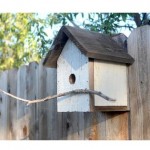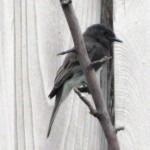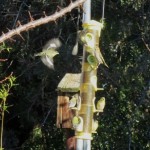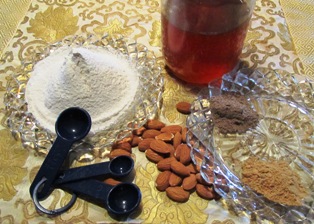How to Attract Birds to Make Your Garden a Sanctuary
A Chinese proverb states that “If I keep a green bough in my heart, then the singing bird will come.” I think I was born with that green bough in my heart because I have always loved birds–and not only the songbirds.
By offering food, water, and safe and dry housing as well as blooms for every season (flowering annuals, perennials, herbs, bulbs, and fruits and berries), I am able to attract many different birds into my garden.When birds are present, especially the songbirds, the garden becomes a special sanctuary.

A hummer’s iridescent feathers shimmer as it perches in sunlight at the end of an apricot tree branch
I hang feeders and fill them with various types of seed and suet cakes as well as syrup for hummingbirds. Food attracts local and migratory birds flying through this time of year. It’s best to choose a wide sampling of foods such as seeds, nuts,hulled sunflower, safflower, Nyjer thistle, peanut, millet, fruit, berries, raisins, and meal worms to draw interesting bird traffic.
Some of the birds we regularly see include scrub jays, wrens, finches, sparrows, red-tail hawks, mockingbirds, quail, mourning doves, robins, barn owls, hummingbirds, and crows.
With food scarce in the wild, the birds visit the hanging and platform feeders. For ground feeders like mourning doves, I put out a large saucer under the apple tree and, yes, I leave a few apples on the tree for the birds to peck. For a list of birds and the types of seed and other foods they consume, see, https://www.wild-bird-watching.com/Bird_Seed.html

Mourning doves mate for life; these two are joined at the feeder by a third who has lost his or her partner
Some of our winged visitors stick around to mate and build nests in climbing rose bushes, brush piles, trees, or one of the many birdhouses we’ve hung. Only the owl basket high in the pepper tree remains empty, but we’ve heard a lot of hooting at night so we’re optimistic that owls will take up residence here. We live close to designated agricultural lands and the empty field behind us has a lot of mice–their favorite food.

My hubby built this birdhouse from a fence board. Not all birds will take up residence in a house, but many will.
Birds build nests in backyard birdhouses and brush piles as well as in trees, shrubs like climbing roses, and under the protected eaves of buildings (mourning doves especially seem to like these). Hummingbirds will build their tiny cup-like nests in shrubs (we found one in our Cecil Brunner climbing rose bush) and trees, from 10 feet and up in locations where wind isn’t a threat.
A water source is important for attracting birds since they both drink and bathe in the water fountains and bird baths of backyards and gardens.
If you provide food, water, and a safe and dry shelter for the birds to eat, breed, and nest, you will be rewarded for not only the singing birds will come but other interesting species as well.
_______________________________________________________
If you enjoy reading about living close to the earth and a good yarn, check out my Henny Penny Farmette series of cozy mysteries: A BEELINE TO MURDER, THE MURDER OF A QUEEN BEE, and my latest, A HIVE OF HOMICIDES.
These mysteries are chock-full of tips for keeping chickens and bees, growing heirloom fruits and vegetables, and backyard DIY projects. For more information, click on the URL.
A HIVE OF HOMICIDES
Nuts and Honey Add Lovely Flavor to Dried Fruit Tart
Flaky tarts piled high with fresh organic berries has always been for me a delightful way to end a summer meal. With the onset of winter now only eleven days away, I flip through my recipe files for something similar to those lovely summer tarts and hit upon an easy-to-make tart filled with dried fruits, nuts, and honey.
You can substitute or add other dried fruit (cranberries, figs, dates, and raisins, for example) to this tart, but I’ve found the best flavor comes from the dried peaches and apricots. They combine beautifully to create a richly flavorful dessert. A dollop of whipping cream on top adds a layer of decadence to this rich autumn tart.
Pastry Ingredients:
1 1/4 cup flour
1/4 cup sugar
1/2 cup unsalted butter (cut into pats or small pieces)
pinch of salt
1 large egg yolk
Directions for Pastry:
Combine pastry ingredients in a food processor with metal blade. Process until the mixture becomes a fine crumble. Add egg yolk and process into dough. Pastry should hold together, forming a ball.
Filling Ingredients:
3/4 cup white dessert wine
3/4 cup honey
18-20 dried apricots and/or peaches
1/2 teaspoon grated orange rind
1 cup blanched whole almonds
3 eggs
1 teaspoon good quality vanilla
2 Tablespoons unsalted butter
1 cup walnuts
Topping:
1 cup cream
1/4 teaspoon cinnamon
1 teaspoon of sugar
Directions for Toasted Almonds:
Preheat oven to 350 degrees Farenheit.
Toast blanched almonds on a baking sheet for 10 minutes. Remove and set aside. Keep oven on for baking the tart.
Directions for Tart Filling:
In a stainless steel pan, add the dried fruit with the orange rind.
Pour over the fruit and rind half the wine and 2 Tablespoons of honey.
Cook over low heat for 20 to 25 minutes until the fruit absorbs the liquid and plumps up, becoming soft and plaint.
In a bowl, combine eggs, honey, remaining wine, vanilla, and butter.
Beat in the walnuts and almonds.
In a springform pan, press the dough as thinly as possible over the bottom and up the sides of the pan. Drop the fruit onto the dough, spreading around over the bottom of the pastry. Pour in the nuts and egg mixture. Use a spatula to smooth the filling.
Bake the tart for 45 minutes on the middle rack of the oven.
Allow the tart to cool in its pan before removing and placing on a serving plate.
Whip cream until peaks form and fold in cinnamon and sugar. Put a dollop on top of each individual serving.
Serves 8.
Old World Honey Cake
Honey cake has been called the world’s “oldest-known cake.” Versions of the cake date to biblical times, although food historians will tell you that it wasn’t really called cake back then. The English term “cake” dates to the thirteenth century and derives from the old Norse word, “kaka.”
Modern pastry chefs have the ancient Egyptians to thank for pioneering the culinary process of baking. The ancients’ version of honey cake was most likely an old-world type of flat bread drizzled or lashed with honey, the sweetener of choice during ancient times. In fact, bread and cake (even today) are not too different. Think of pumpkin bread or banana nut bread. A slice of either at breakfast is like having dessert in the morning.
The Romans added eggs and butter to get a lighter dough. Cooks began to add nuts and dried fruits such as dates, figs, and raisins to make their honey “cake” even more mouth-watering and special.
Although that round shape that we associate with cake today didn’t emerge until the seventeenth century, medieval bakers in Europe had for centuries continued to create new versions of the honey cake with spices such as ginger. In fact, the taste for ginger resulted in gingerbread. The addition of dried fruits, nuts, spices, and (later) rum and brandy yielded the cake we know today as fruitcake.
The following recipe is more of a medieval style honey cake, although during the medieval period cakes tended to be smaller than we think of them today.
Old World Honey Cake
Ingredients:
1 cup plus 1 tablespoon honey (preferrably dark)
1 teaspoon cinnamon
1/2 teaspoon ground nutmeg
1/2 teaspoon cardamom
2 teaspoon baking soda
1/2 cup softened unsalted butter
1 cup dark brown sugar
4 eggs (separate yolks from whites)
1/2 cup unflavored Greek yogurt
1/2 cup cottage cheese
1 tablespoon fresh orange zest
2 1/2 cups flour
1/2 teaspoon salt
1/2 cup raisins
10 dates, stoned and chopped
1 cup walnuts, finely chopped
Directions:
Preheat the ove to 300 degrees Fahrenheit. Grease a ten-inch tube pan.
Combine honey, cinnamon, nutmeg, and cardamom in a saucepan over medium high heat and bring to a boil, stirring often. Add baking soda, stir in, and remove from heat and let cool.
In a mixing bowl, cream butter with brown sugar. Beat in one egg yolk at a time. Add this to the honey/spice mixture.
In a bowl, mix yogurt, cottage cheese, and orange zest.
Sift half the flour and the salt into the honey/spice mixture (that now also contains the creamed butter, sugar, and eggs). Combine remaining flour with raisins, dates, and walnuts. Mix this into the bowl of batter.
Pour the batter into the greased tube pan and bake for 1 1/2 hours. Test for doneness by inserting a toothpick into the cake. The toothpick, when pulled out, should have no batter on it.
Cool the cake for 15 minutes before inverting. Brush with 1 Tablespoon of honey.
Optional: Sprinkle with slivered almonds. After the cake is completely cooled, store in an airtight container for 24 to 48 hours before serving.
Copyright Meera Lester 11-28-2012
 Facebook
Facebook Goodreads
Goodreads LinkedIn
LinkedIn Meera Lester
Meera Lester Twitter
Twitter








